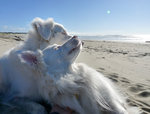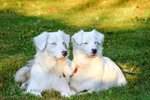

Nothing pulls on the heart strings of an emotional female quite like a sad story and, I suppose, December of 2013 I was prime for one. Having just put down our last of six cats at his tender age of 18, our house was eerily quiet.
I believe in providence and the outcome of my next course of actions only served to solidify that belief. When flipping through the first edition of The Reflector for 2014, a special ad caught my eye, right under a story I had written and attached the photo of my beloved cat to. The photo of two white dogs huddled together jumped out at me and I knew I had to meet them.
My husband and I weren’t in the market for one dog let alone two and these two were quite unique. Both deaf and sight-impaired, they would be an undertaking. What we met at the Humane Society for SW Washington (HSSWW) were two timid dogs and what Tara Zimmerman, canine enrichment specialist for HSSWW, told us about their journey made me want them more — and not want them more simultaneously.
These two, a boy and a girl, had been found abandoned on property in La Center tied to a tree and covered in muck. They’d spent one month at the HSSWW and, in that time, it had been decided they must be adopted together. They were considered a bonded pair, better off together than separated. Sad story just turned sadder. What’s a girl to do?
Three days later, we brought them home. Volunteers at the HSSWW had named them Charming and Snow after a popular-at-the-time television series. It took about a week walking the boy to conclude he must be named Challenge. He is a strong, determined and stubborn boy. I observed the way he guarded her; standing over her when he sensed a threat and scolding her if she drew too much attention to herself. I decided that Baby Girl seemed fitting. She’s a flitty little princess who is sure the whole world is there to protect her and look after her so that she doesn’t have to expend energy on such trivial matters.
Together, they cause quite a stir with their white coats and it is such a treat to see the smile on people’s faces when they catch sight of this cute couple walking all over Battle Ground. And, oh, do we walk. Considered predominantly Australian shepherds, they are inherently highly intelligent so, with dulled senses, they bore easily. The best remedy for that is regular exercise; twice a day, every day, rain or shine. Lucky me!
So, what happened? Simply put; they were bred wrong. Challenge and Baby Girl are double merle Australia shepherds; often incorrectly referred to as lethal white which is a fatal genetic disorder that affects horses. Double merle stems from incorrectly or irresponsibly breeding two merles (a gene detected by blood work), resulting in a 25 percent chance that each puppy will be deaf and blind or sight-impaired. See, for dogs, hearing is carried in the pigment of their inner ear hairs. No pigment equals no sound.
The question becomes, how do you talk to a deaf dog? Born with cataracts in three of their four eyes and all four eyes being microphthalmic (abnormally small), their vision is limited so sign language is ineffective beyond a few feet. Additionally, Challenge suffered a detached retina in one eye in 2015 which is a common possibility with eye issues.
It’s all in the touch. Early on we were introduced to Deaf Dogs of Oregon, an awesome organization located outside Portland that rescues double merles from all over the U.S., trains them and places them in forever homes. Trainer Chelsea Tuning was instrumental in teaching us to talk to our new family members. A scruff under the chin means come, a sharp double tap on the right shoulder blade means “no,” a double tap on the hind end means sit and so forth. Consistency is key in any form of training and consistent placement of touch commands is essential to avoid frustration in these task-oriented dogs.
Jan. 7 we celebrate four years with Challenge and Baby Girl. They aren’t the bonded pair they once were although they are still quite close and cue off each other. The vet says that Baby should see as poorly as Challenge does but I call her my faker because the way she can run circles around my husband and me on the beach is remarkable for a dog with limited vision. But her starburst eyes are very real, an unequivocal fact that her pupils are incomplete.
Which leads me to only one conclusion — that special needs dogs are so much more than what they are not. They do what they need to do to adapt and, as Tuning points out, dogs are not hindered by ruminating. They are deaf and sight-impaired and that’s just the way it is.
One thing that is hard to communicate with people is the fact that they need a slow introduction to other dogs. Dogs greet one another with visual cues; ears up or down, tail wagging or pointed. Challenge and Baby cannot see those things and dogs that move quickly are like a person jumping into our faces; that is startling and our first thought is to defend ourselves.
Had they been born into a home with hearing and sighted dogs and had the opportunity for positive socialization at a young age, things might be different, but their first three years are a complete unknown to us. Judging from their timid behavior and the wounds on Challenge’s nose and hind quarters when we first adopted him, I’d say those first three years were anxious and stressful.
Special needs dogs are not for everybody. I’ve spent countless hours socializing them to build their confidence and they’ve been allowed places other dogs might not be allowed because of their special needs and their extremely mellow temperaments (which, I’m told, is highly unusual for double merles). They are resolutely loyal and so appreciative of the person who takes the time to figure out how to talk to them.
When Challenge takes an extended time to survey his fenced back yard before turning in for the night and Baby Girl is peacefully chewing on a rawhide, our hearts are full knowing that we are a part of their happily ever after.